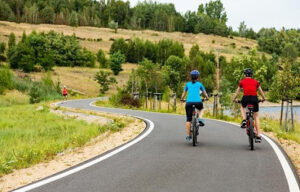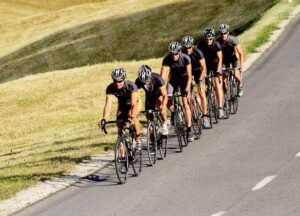Cycling Etiquette: 5 Rules of the Road

The world of cycling can seem like a foreign country you are visiting with its own rules and taboos. It’s easy to feel confused and even a little overwhelmed, but the rules of the road are there to keep you and those around you safe so you can enjoy your ride. Read on to find out the top 5 tips for proper biking etiquette.
1.Where you ride matters
If you read my last blog, you know that riding in the street, on the shoulder, or on the sidewalk has an impact on your safety. But it’s also worth considering how this choice affects those around you. If you’re up on the sidewalk weaving around pedestrians, you’ll probably scare a few and potentially cause an accident.
Lots of cyclists like to use multi-use pathways such as old railroad grades that are now paved pathways. These will be shared with walkers, runners, dogs, roller-bladers, and any other moving thing imaginable! Look ahead for slower users and pass on the left. You will probably have to ride more slowly on a multi-use pathway than on the shoulder of a street.
If riding off-road on single-track, you should yield to pedestrians and give horses a lot of space (as they are often spooked by bikes). Try to be aware if someone wants to pass you and pull to the side when safe to do so.
2. Use audible signal

Pedestrians and other cyclists can’t usually see you coming up from behind. It is important to let them know you are passing by calling out, “on your left!” or “passing!” This ensures that they don’t suddenly move into your path and cause a collision, and it keeps them from being startled.
A group of riders will also commonly shout to each other about intersections or cars. “Car back!” warns others that there is a car wanting to pass, and “clear!” means that the intersection is clear and there is not a car coming. This being said, for safety, I always still look when I approach the intersection and don’t entirely rely on the shouting (just in case there really IS a car coming!).
Unfortunately, I have noticed recently that calling out to pedestrians has become less and less effective due to headphones. Noise-canceling headphones may completely eliminate your voice warning, so be aware if someone does not seem to acknowledge you and give some extra space. (As a side note, it’s safer not to go walking alone with noise-canceling headphones, as you become a big target for criminals or animals when completely unaware of your surroundings.)
3. Stay out of cars’ way

As I wrote in the last blog, you legally have the right to ride in the middle of a lane and block traffic. It’s even legal in Washington state to ride two-abreast. But the more you slow motorists down, the angrier they will become, which could lead to a road-rage incident. It’s most considerate to ride to the side giving cars room to pass. Ideally, they will give you three feet of space, but not every road allows for this, so ride a straight and steady line in traffic.
It’s also a good idea to give a little wave of thanks when a motorist yields to you. They appreciate being acknowledged for the small inconvenience of sharing the road.
4. Buzzing pedestrians

When you’re riding with a group of cyclists, you may be rolling along within inches of each other. Even when a cyclist is stopped alongside the road, they expect to come in close contact with other bikes. Pedestrians, however, do NOT like being buzzed so closely. You should ideally leave at least 3 feet as you pass to avoid giving an adrenaline jolt.
Dogs and horses should be given even more space, as animals often process you as a threat and may jump or spook. The last thing you want is to injure someone who gets thrown from their horse.
5. Drafting

Road cyclists love drafting, which is riding as closely as possible behind someone to get an aerodynamic advantage. You can save 30% of your energy by doing this! However, it can be dangerous if you don’t communicate clearly with those around you.
If you come up behind a stranger, you should not just draft; you should stay a reasonable distance back until it’s safe to pass or talk to them. When you’re drafting, you’re relying on the person in front to ride straight and not stop suddenly. If they don’t know you’re there, they may ride more erratically and cause an accident.
If you’d like to draft behind someone you encounter, you should ride up beside them and ask if they would like to do so. Then you should take turns being in front. When in front, ride smoothly at an even pace and as straight as possible. Use hand signals to indicate when you are slowing or turning, and point to the side if there is an obstacle ahead (remember, the rider behind may not be able to see what’s coming since they are so close to you).
In a larger group, riders will typically take a few minutes in front and then pull to the side, slow down, and then ride on the back of the line so that everyone shares the drafting. If you don’t feel comfortable taking the lead, you can just pull off immediately when it’s your turn. However, if you’re riding fast and everyone is suffering, it’s going to look unfair if you don’t take your turn upfront and let other riders rest.
Now that you know the rules, get out and have fun!
By being considerate of others, you will ensure that everyone has fun and stays safe. If you do end up in an accident despite your best efforts, come visit Kintsugi Physical Therapy to help heal yourself fully. We also offer bike fitting to make your riding more comfortable and efficient.
